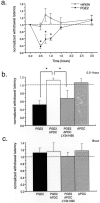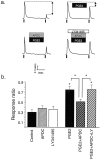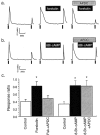Peripheral group II metabotropic glutamate receptors (mGluR2/3) regulate prostaglandin E2-mediated sensitization of capsaicin responses and thermal nociception
- PMID: 12151517
- PMCID: PMC6758177
- DOI: 10.1523/JNEUROSCI.22-15-06388.2002
Peripheral group II metabotropic glutamate receptors (mGluR2/3) regulate prostaglandin E2-mediated sensitization of capsaicin responses and thermal nociception
Abstract
Previous studies have shown that group II metabotropic glutamate receptors (mGluRs) are present on the peripheral terminals of primary sensory neurons, suggesting that they might be involved in nociception. In this study, we investigated the modulation of nociception by peripheral group II mGluRs and the molecular basis of this modulation. Subcutaneous injection of a group II mGluR agonist, 2R,4R 4-aminopyrrolidine-2,4-dicarboxylate (APDC), did not alter thermal sensitivity but blocked prostaglandin E2 (PGE2)-induced thermal hyperalgesia. This effect was blocked by (2s)-2-amino-2-[(1s,2s)-2-carboxycycloprop-1-yl]-3-(xanth-9-yl) propanoic acid, a selective group II mGluR antagonist. In cultured primary sensory neurons, APDC blocked PGE2-induced potentiation of capsaicin responses, which was abolished when neurons were pretreated with pertussis toxin. Similar potentiating effects induced by forskolin but not 8-bromo-cAMP were also blocked by the activation of group II mGluRs. These results indicate that peripheral group II mGluRs act via inhibition of adenylyl cyclase to reverse the sensitization of capsaicin receptors and the thermal hyperalgesia induced by PGE2, and suggest that peripheral group II mGluRs might be targeted for therapeutic intervention in inflammatory pain states.
Figures




Similar articles
-
Group II/III metabotropic glutamate receptors exert endogenous activity-dependent modulation of TRPV1 receptors on peripheral nociceptors.J Neurosci. 2011 Sep 7;31(36):12727-37. doi: 10.1523/JNEUROSCI.6558-10.2011. J Neurosci. 2011. PMID: 21900552 Free PMC article.
-
Prostaglandin and protein kinase A-dependent modulation of vanilloid receptor function by metabotropic glutamate receptor 5: potential mechanism for thermal hyperalgesia.J Neurosci. 2002 Sep 1;22(17):7444-52. doi: 10.1523/JNEUROSCI.22-17-07444.2002. J Neurosci. 2002. PMID: 12196566 Free PMC article.
-
Group II metabotropic glutamate receptor activation attenuates peripheral sensitization in inflammatory states.Neuroscience. 2008 Jun 23;154(2):754-66. doi: 10.1016/j.neuroscience.2008.03.084. Epub 2008 Apr 16. Neuroscience. 2008. PMID: 18487022 Free PMC article.
-
Selective inhibition of forskolin-stimulated cyclic AMP formation in rat hippocampus by a novel mGluR agonist, 2R,4R-4-aminopyrrolidine-2,4- dicarboxylate.Neuropharmacology. 1995 Aug;34(8):843-50. doi: 10.1016/0028-3908(95)00061-a. Neuropharmacology. 1995. PMID: 8532165
-
Group II Metabotropic Glutamate Receptors: Role in Pain Mechanisms and Pain Modulation.Front Mol Neurosci. 2018 Oct 9;11:383. doi: 10.3389/fnmol.2018.00383. eCollection 2018. Front Mol Neurosci. 2018. PMID: 30356691 Free PMC article. Review.
Cited by
-
Metabotropic glutamate receptors: from the workbench to the bedside.Neuropharmacology. 2011 Jun;60(7-8):1017-41. doi: 10.1016/j.neuropharm.2010.10.022. Epub 2010 Oct 29. Neuropharmacology. 2011. PMID: 21036182 Free PMC article. Review.
-
Metabotropic glutamate antagonists alone and in combination with morphine: comparison across two models of acute pain and a model of persistent, inflammatory pain.Behav Pharmacol. 2011 Dec;22(8):785-93. doi: 10.1097/FBP.0b013e32834d13a2. Behav Pharmacol. 2011. PMID: 21971021 Free PMC article.
-
Scaffolding by A-kinase anchoring protein enhances functional coupling between adenylyl cyclase and TRPV1 channel.J Biol Chem. 2013 Feb 8;288(6):3929-37. doi: 10.1074/jbc.M112.428144. Epub 2012 Dec 21. J Biol Chem. 2013. PMID: 23264624 Free PMC article.
-
Surgical extraction of human dorsal root ganglia from organ donors and preparation of primary sensory neuron cultures.Nat Protoc. 2016 Oct;11(10):1877-88. doi: 10.1038/nprot.2016.111. Epub 2016 Sep 8. Nat Protoc. 2016. PMID: 27606776 Free PMC article.
-
Group II mGluRs suppress hyperexcitability in mouse and human nociceptors.Pain. 2016 Sep;157(9):2081-2088. doi: 10.1097/j.pain.0000000000000621. Pain. 2016. PMID: 27218869 Free PMC article.
References
-
- Bhave G, Karim F, Carlton SM, Gereau RW. Peripheral group I metabotropic glutamate receptors modulate nociception in mice. Nat Neurosci. 2001;4:417–423. - PubMed
-
- Birnbaumer L, Stengel D, Desmier M, Hanoune J. Forskolin regulation of liver membrane adenylyl cyclase. Eur J Biochem. 1983;136:107–112. - PubMed
-
- Boxall SJ, Berthele A, Laurie DJ, Sommer B, Zieglgansberger W, Urban L, Tolle TR. Enhanced expression of metabotropic glutamate receptor 3 messenger RNA in the rat spinal cord during ultraviolet irradiation induced peripheral inflammation. Neuroscience. 1998;82:591–602. - PubMed
-
- Carlton SM, Hargett GL, Coggeshall RE. Localization and activation of glutamate receptors in unmyelinated axons of rat glabrous skin. Neurosci Lett. 1995;197:25–28. - PubMed
-
- Carlton SM, Hargett GL, Coggeshall RE. Localization of metabotropic glutamate receptors 2/3 on primary afferent axons in the rat. Neuroscience. 2001;105:957–969. - PubMed
Publication types
MeSH terms
Substances
Grants and funding
LinkOut - more resources
Full Text Sources
Other Literature Sources
